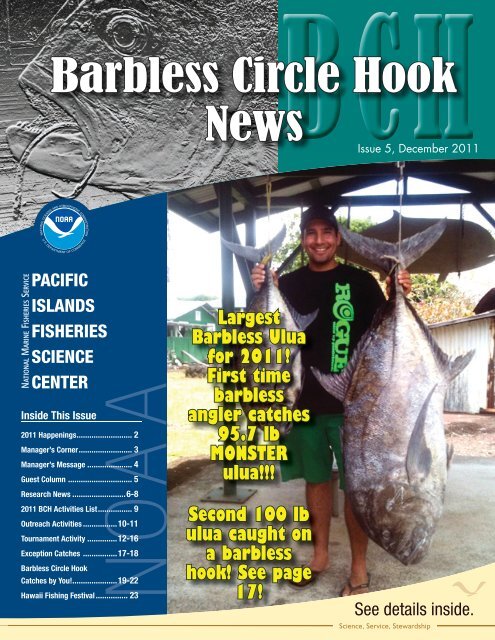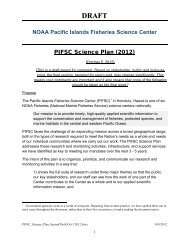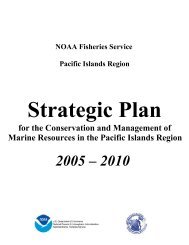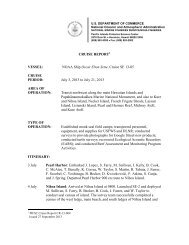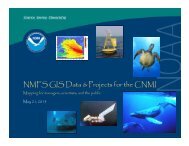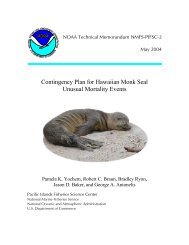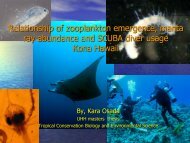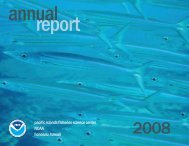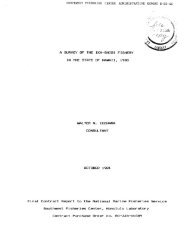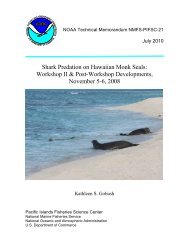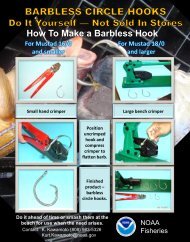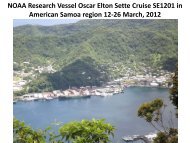Barbless Circle Hook News - Pacific Islands Fisheries Science ...
Barbless Circle Hook News - Pacific Islands Fisheries Science ...
Barbless Circle Hook News - Pacific Islands Fisheries Science ...
You also want an ePaper? Increase the reach of your titles
YUMPU automatically turns print PDFs into web optimized ePapers that Google loves.
<strong>Barbless</strong> <strong>Circle</strong> <strong>Hook</strong><br />
<strong>News</strong><br />
<strong>News</strong><br />
Issue 5, December 2011<br />
NATIONAL MARINE FISHERIES SERVICE<br />
PACIFIC<br />
ISLANDS<br />
FISHERIES<br />
SCIENCE<br />
CENTER<br />
Inside This Issue<br />
NOAA<br />
2011 Happenings .......................... 2<br />
Manager’s Corner ......................... 3<br />
Manager’s Message ..................... 4<br />
Guest Column .............................. 5<br />
Research <strong>News</strong> .........................6-8<br />
2011 BCH Activities List ................ 9<br />
Outreach Activities ................10-11<br />
Tournament Activity ..............12-16<br />
Exception Catches ................17-18<br />
<strong>Barbless</strong> <strong>Circle</strong> <strong>Hook</strong><br />
Catches by You! .....................19-22<br />
Hawaii Fishing Festival ............... 23<br />
Largest<br />
<strong>Barbless</strong> Ulua<br />
for 2011!<br />
First time<br />
barbless<br />
angler catches<br />
95.7 lb<br />
MONSTER<br />
ulua!!!<br />
Second 100 lb<br />
ulua caught on<br />
a barbless<br />
hook! See page<br />
17!<br />
See details inside.<br />
<strong>Science</strong>,<br />
<strong>Science</strong>, Service,<br />
Service, Stewardship<br />
Stewardship 1
2011 Happenings<br />
NEWS FLASH – June 2011 – First-time barbless angler Stephen Arquitola<br />
catches 95.7 pound ulua on barbless circle hooks he got at the last Pole Benda<br />
tournament. “I received free hooks at the NOAA booth which was set up at the<br />
Pole Benda Tournament and figured I'd try it out. Was this my first time...yes, never<br />
used barbless before.”<br />
Stephen Arquitolo, largest 2011 BCH ulua, 95.7 lbs.<br />
The rest is history.<br />
June 2011. Stephen Arquitola describes the<br />
events of the day like this: “I took my friend fi shing<br />
because it was his birthday. So we decided to go<br />
to our secret spot. We<br />
were fi shing small game<br />
and I hooked up a good<br />
size akule, so I decided<br />
to slide it on my barbless<br />
16/0 hook. The strike<br />
came about 15 minutes<br />
later and the battle was<br />
on. It took a good initial<br />
run and almost drained<br />
my 454 Newell. I fi nally<br />
stopped him and began<br />
to bring him in. He took two more runs and fi nally<br />
gave up. The battle lasted about 15 minutes. It was<br />
the best fi ght so far for me.”<br />
Keep up the good work guys! The 2011 season<br />
was full of the usual “barbless challenges”, a few<br />
new tournaments and fi shing club contacts as well as the end of an old familiar tournament that will<br />
be missed.<br />
Seven tournaments featured a “barbless challenge” within the usual tournament formats. The Atlapac<br />
Weighmaster Obake Shootout, the 2nd annual Nanko’s Eastside Challenge, the 3rd annual<br />
GT Masters Cup, the 13th annual Pole Benda, the Tokunaga Ulua Challenge, and the 36th annual<br />
Hilo Casting Club tournament. The <strong>Barbless</strong> <strong>Circle</strong> <strong>Hook</strong> (BCH) Project also continued with its fi shing<br />
club, keiki, and other outreach activities during the busy year.<br />
2 <strong>Barbless</strong> <strong>Circle</strong> <strong>Hook</strong> <strong>News</strong>
Manager’s Corner<br />
This year was another year of successful outreach activities. The successes of this<br />
project all start with you the fisherman. Many thanks to all of the tournament<br />
organizers who included the “<strong>Barbless</strong> Challenge” into their formats. Unfortunately<br />
I couldn’t be everywhere at the same time, so I must apologize because I could not<br />
accommodate all invitations. I hope the funding continues and that there will be more<br />
time to get to all the tournaments and outreach opportunities in this coming year.<br />
The BCH project went to the first International <strong>Circle</strong> <strong>Hook</strong> Symposium this year.<br />
The project made a poster presentation which was very well received. The mainland<br />
folks were surprised that we used circle hooks as a standard shoreline hook; they had<br />
no idea about what we use much less that we have gone further and are now “going<br />
barbless” voluntarily. Most of the mainland anglers are only now hearing about using<br />
circle hooks. It was interesting that many talks dealt with “how to fish” or “set” the<br />
circle hook. I’m glad to be working in Hawaii with all of you guys.<br />
Thanks again for trying out and using barbless circle hooks. Whenever I go shorecasting<br />
I lose a bunch of leads and bankrupt quite a lot in certain areas. Checking bait<br />
regularly and bankrupting in the process made me realize how much more we are doing<br />
to help out the fish by going barbless. Thinking about all the still baited hooks on my<br />
bankrupt rigs and the potential for anything picking them up and getting hooked made<br />
me realize that this is yet another way that we can help minimize some post-hooking<br />
injury. This is especially true since we don't have control over anything hooked up on<br />
a bankrupt rig so by taking advantage of the self-shedding properties we can still help<br />
conserve our resources even if we bankrupt occasionally. Just something for everyone<br />
to think about when you go fishing or cannot sleep at night.<br />
I<br />
would also like to thank Brian Kimata for his thoughts and contribution of the article<br />
on the use of offset circle hooks. I also believe likewise and therefore have not given<br />
out offset barbless circle hooks for the project. Thanks Brian for your thoughts.<br />
Finally, a reminder to fish responsibly, show respect to other beach goers, and<br />
please keep our fishing areas cleaner than when you arrived. Thanks for being role<br />
models.... kurt<br />
<strong>Science</strong>, Service, Stewardship 3
Manager’s Message<br />
Program Manager’s Message<br />
IT WORKS!<br />
The ease of shedding a barbless circle hook has been on record<br />
now since 2007. Every year an average of 5-10 seals show<br />
up with a barbed circle hook in some part of their body. The<br />
undeniable “proof” that the barbless circle hooks could easily be<br />
self-shed comes from this 2007 Big Island incident which was<br />
documented by NOAA researchers.<br />
“Well, we got super lucky last night and got the hook<br />
out without even touching the seal. I’ve attached two<br />
pics so you can see the hook in the mouth and the<br />
hook by itself. It appears that the fisherman may<br />
have cut off the barb so the seal actually pulled the<br />
hook out herself when she reacted to me getting<br />
close, she moved away and popped it right out!!”<br />
A lot of unintended interactions can have a similar outcome if<br />
barbless circle hooks are used by responsible fi shermen. Many<br />
thanks to the fi sherman who used this one…you were defi nitely<br />
ahead of the game.<br />
Please practice responsible fi shing.Keep on using them. – Kurt<br />
DIY barbless hook – not sold in stores.<br />
4 <strong>Barbless</strong> <strong>Circle</strong> <strong>Hook</strong> <strong>News</strong>
Guest Column<br />
The Truth Behind Offset <strong>Circle</strong> <strong>Hook</strong>s<br />
by Brian Kimata<br />
Some people bend them themselves. Some people buy them that way. At some time, you<br />
probably have used them yourselves. What are they? I’m referring to offset circle hooks and<br />
why you shouldn’t be using them. But first of all, what is an offset circle hook? Well let’s start<br />
with what’s a non-offset circle hook. Non-offset circle hooks are circle hooks that have a tip that<br />
is bent back in a plane parallel, or nearly parallel to the shank. They’re the most common form<br />
of circle hooks and the ones you are most likely to see. By contrast, the Atlantic States <strong>Fisheries</strong><br />
Commission defines a non-offset hook as one with the point turned back perpendicular to the<br />
shank. The point is bent back with a major deviation from the plane parallel to the shank. As a<br />
Honolulu tackle store owner, I try to help my customers hook and land more fish. Offset circle<br />
hooks have been proven to be less effective with less strike and penetration force. To visualize this<br />
inefficiency, imagine attempting to drive a nail when it’s placed at an angle to the board. Its energy<br />
is not directed to the point squarely making it much more difficult. They also tend to hang up on<br />
the ocean floor easier, so you can see why I try not to recommend them.<br />
Offset circle hooks also harbor a much darker side. Studies from the Marine Resource Research<br />
Institute (MRRI) have shown that offset circle hooks have deep hooking rates (gut and throat<br />
hooking), of 23%, and mortalities of 10% (South Carolina Dept. of Natural Resources data). By<br />
contrast, sailfish catch and release data show deep hooking catches of just 2% with standard circle<br />
hooks. (Prince et al. 2002). This should not be surprising as non-offset hooks were designed to lip<br />
or jaw hook fish. Non-offset hooks have even been pulled from fish stomachs as the rolled parallel<br />
tip avoids the throat and gut cavity. This does not happen with offset hooks, and larger offset<br />
angles increase the likelihood of a deep hooking.<br />
This reduction in deep hooking is so dramatic that as of June 1, 2008, Florida requires nonoffset<br />
circle hooks while bait fishing in the Gulf Coast. The federal government still allows the<br />
use of offsets there but discourages their use.<br />
While I could not find any deep hooking data on non-fish species it would seem logical that<br />
increases would occur here as well. Incidental hooking of turtles and seals occur and the<br />
use of non-offset circle hooks can help protect these populations too. A 2007 NOAA-documented<br />
incident indicates that seals are capable of removing a barbless circle hook themselves. So, the<br />
next time you think of bending your circle hook, bend the barb down and leave the tip alone.<br />
You’ll help the environment and put more fish in your cooler too!<br />
Prince Ed, Ortiz M, Venizelos A. 2002. A comparison of circle hook and "J" hook performance in recreational catchand-release<br />
fisheries for billfish. American <strong>Fisheries</strong> Society Symposium 30:66-79.<br />
<strong>Science</strong>, Service, Stewardship 5
Research <strong>News</strong><br />
Ulua and Oio Tagging Projects<br />
State of HI Ulua Tagging<br />
Project<br />
Aloha fi shermen! It was nice seeing<br />
and meeting with many<br />
of you this summer at various tournaments<br />
around the<br />
state. We<br />
appreciate<br />
all of your<br />
help and<br />
support of<br />
the DAR Ulua Tagging project. Each<br />
year we continue to grow and recruit<br />
new volunteers each season.<br />
We currently have more than 3500<br />
volunteer anglers in our project<br />
that have tagged close to 38,000<br />
papio/ulua statewide! Along with<br />
almost 5000 recoveries, of which<br />
more than half (2650) have been<br />
re-released giving us a huge amount<br />
of data.<br />
Total Ulua Tagged<br />
200<br />
180<br />
160<br />
140<br />
120<br />
100<br />
80<br />
60<br />
40<br />
20<br />
0<br />
Total Ulua Tagged per Year 2000 to 2010<br />
7<br />
43 46 42<br />
91<br />
75 75<br />
125<br />
139<br />
142<br />
2000 2001 2002 2003 2004 2005 2006 2007 2008 2009 2010<br />
Year<br />
190<br />
A growing trend with support from<br />
the Pacifi c <strong>Islands</strong> <strong>Fisheries</strong> Group<br />
and many tournaments statewide<br />
has been the increase in numbers<br />
of ulua tagged each year. We have<br />
seen since the start of our project<br />
this number steadily increase year<br />
after year. Much of the tagging has<br />
occurred during papio/ulua tournaments<br />
which host the PIFG Tagging<br />
Challenge. These tournaments recognize<br />
the need to support the Ulua<br />
Tagging Project while at the same<br />
time helping conserve our precious<br />
resource. (See graph). This is a winwin<br />
situation for all, especially for<br />
our papio and ulua.<br />
We have also been busy collecting<br />
papio/ulua heads and gonads for<br />
life history studies. So far, with generous<br />
donations from many anglers,<br />
we have collected close to 200<br />
samples of omilu and white papio/<br />
ulua of various sizes. NOAA <strong>Fisheries</strong><br />
<strong>Science</strong> Center is assisting us<br />
with analysis and the reading of the<br />
otolith to determine the age of individual<br />
fi sh. This information will be<br />
used to update the main Hawaiian<br />
<strong>Islands</strong> age and growth curves for<br />
the omilu and whites.<br />
We would like to thank all of the anglers<br />
of Hawaii for their tremendous<br />
support and participation. Together<br />
we will be able to better manage<br />
our papio and ulua resources for future<br />
generations.<br />
Clay Tam,<br />
Ulua Tagging Project<br />
Oio Tagging Project<br />
The Oio Tagging Project had a<br />
great year in 2011! Membership<br />
has risen to over 400 volunteers<br />
state wide. Over 2500<br />
tagged fi sh have been reported<br />
and since July 2009, 32 tagged<br />
oio have been recaptured. The Oio<br />
Tagging Project expanded in 2010<br />
by sponsoring<br />
oio tagging<br />
categories in<br />
the two ATLA-<br />
PAC fi shing<br />
tournaments,<br />
the Obake<br />
Shootout held October 1-3 and the<br />
oio Invitational held December 3-5.<br />
Many great prizes were awarded<br />
through a participant lottery drawing<br />
such as 13 ft shore casting rod<br />
and reel combos and hand-held<br />
GPS units. This gave the project<br />
more exposure and interaction with<br />
recreational fi shers and more anglers<br />
volunteered to tag oio. We<br />
look forward to supporting ATLA-<br />
PAC in their 2011 fi shing tournaments<br />
and sponsoring more oio<br />
tagging categories in 2012.<br />
Now in its third year, the tagging<br />
project has received even more<br />
support from the fi shing community<br />
through continued involvement and<br />
additional exposure from the Hawaii<br />
Goes Fishing episode that fi rst aired<br />
April 29, 2011 (http://www.you-<br />
tube.com/watch?v=48lWY_iCy-<br />
PU).<br />
Much Mahalo to all the project<br />
volunteers and supporters and we<br />
look forward to another great year<br />
in 2012!<br />
Kimberlee Harding,<br />
Oio Tagging Project Coordinator<br />
http://oiotaggingproject.com/<br />
6 <strong>Barbless</strong> <strong>Circle</strong> <strong>Hook</strong> <strong>News</strong>
Research <strong>News</strong><br />
PIFG Oio Tagging<br />
Project<br />
PIFG’s project to tag<br />
and release 3000 oio<br />
or bonefi sh off Oahu’s leeward<br />
coast was launched<br />
in 2010 with the support<br />
of the NOAA Saltonstall-<br />
Kennedy Grant Program.<br />
This project has two primary<br />
goals: 1) to collect<br />
life history information on<br />
fi sh biosamples for length,<br />
weight, gonads, stomach<br />
content, and otoliths.<br />
If you happen to catch<br />
an oio with an unfamiliar<br />
green tag in it please call<br />
PIFG (808) 265-4962 to<br />
report the recovery. The<br />
information you provide<br />
will help to sustainably<br />
manage our oio stocks<br />
for the future. Thank you.<br />
Brian Funai, PIFG<br />
Oio Tagging Project<br />
oio from Hawaiian waters<br />
and 2) to test a new largescale<br />
tagging strategy for<br />
deploying tags. Another<br />
aspect of this project will<br />
be to document the difference<br />
between the two<br />
bonefi sh species found<br />
in Hawaii: the round and<br />
sharp jaw. Prior to this effort,<br />
tagging had been<br />
done primarily on shallow<br />
water fl ats by the rod and<br />
reel fi shing community.<br />
This project targets the<br />
offshore schooling portion<br />
of the bonefi sh population<br />
that has not been previously<br />
targeted by past and<br />
current tagging projects.<br />
So far, 2 tagging trips<br />
have resulted in 1017<br />
oio being tagged with 13<br />
recoveries to date and 43<br />
<strong>Science</strong>, Service, Stewardship 7
Research <strong>News</strong><br />
Monk Seals and Marine Turtles in 2011<br />
Monk Seals<br />
Approximately 200 individual<br />
seals have been<br />
identifi ed living in the main<br />
Hawaiian <strong>Islands</strong>, and<br />
some of them continue to<br />
be accidentally hooked by<br />
shorefi shing gear. In 2010,<br />
10 hooking incidents were<br />
recorded, but the number<br />
has so far diminished in<br />
2011, with only 5 incidents reported through September. A few of<br />
these occurrences have resulted in the seal losing the hook without<br />
assistance, but most require hands-on rescues to remove the gear. As<br />
evidenced by previous rescues, this is potentially dangerous both for<br />
the animal and the researcher alike. The proactive voluntary use of a<br />
self-shedding barbless circle hook by fi shermen could result in a less<br />
injurious outcome should an accidental hooking occur, and ideally the<br />
hook being shed from the animal without human intervention. – John<br />
Henderson, Hawaiian Monk Seal Research Program.<br />
Marine Turtles<br />
Hawaiian sea turtle strandings<br />
have been documented<br />
by the PIFSC Marine Turtle<br />
Research Program since 1982.<br />
There are currently more than<br />
6100 stranding reports of<br />
which approximately 1480<br />
involved fi shing gear such as<br />
line, net, or hooks. Of those,<br />
a little more than half involved<br />
fi shing line and approximately 25% involved hooks. A little over half of<br />
these turtles were successfully released alive. Reports are also received<br />
from recreational divers about entangled or hooked turtles, but these<br />
reports are not included in the stranding reports. By using barbless<br />
circle hooks, sea turtles and other incidentally captured animals may<br />
be easily released without much harm to the animal. It may also prevent<br />
loss of fi shing gear to the fi shermen if the hook can be dislodged<br />
instead of being taken with the animal. – Shawn Murakawa, Marine<br />
Turtle Research Program.<br />
Earl Miyamoto<br />
Lisa White<br />
MARINE WILDLIFE<br />
PROGRAM PARTNERS<br />
WITH BCHP<br />
Who are we? A special project at the<br />
Hawaii Department of Land and Natural<br />
Resources (DLNR)<br />
What’s our main focus?<br />
The prevention and reduction of monk seal and<br />
sea turtle interactions<br />
Our purpose? To reduce the impact of<br />
accidental fishery interactions with monk seals<br />
and sea turtles<br />
How are we doing that? By encouraging<br />
recreational fishermen to fish barbless!<br />
Why fish barbless? Smashing the<br />
barb on your hooks is a quick, proactive measure<br />
to reduce injury to animals that take your<br />
hook. Fishing barbless is a simple gear alternative<br />
and concrete mitigation measure to reduce<br />
the potentially harmful impacts of fishery<br />
interactions on seals and turtles. By smashing<br />
your barb you reduce the post-hooking injury<br />
to the animal. In the event of a hooking you<br />
should feel confident to help as long as you<br />
feel safe. Cut your line as close to the hook as<br />
possible and if the animal is lightly hooked try<br />
to remove the hook. If it’s barbless it should<br />
come out easily!<br />
Mahalo to all of you who are fishing barbless<br />
and to Kurt for allowing us to work with the<br />
BCH project.<br />
Contact us with questions about seals or turtle<br />
at (808) 832-5017.<br />
8 <strong>Barbless</strong> <strong>Circle</strong> <strong>Hook</strong> <strong>News</strong>
2011<br />
<strong>Barbless</strong><br />
<strong>Barbless</strong> <strong>Circle</strong> <strong>Hook</strong> Project Activities<br />
September 2010 ~ August 2011<br />
September 2010<br />
• Mililani Mauka Middle School Fishing Club – 9/28/10<br />
October 2010<br />
• Atlapac Weighmaster Obake Shootout – “BCH Challenge” – 10/3/10<br />
• 5th Annual Fishing and Seafood Festival – 10/10/10<br />
December 2010<br />
• Atlapac Annual Oio Tournament -– “BCH Challenge” 12/5/10<br />
• Nanko and Aloha Army Eastside Challenge – “BCH Challenge” – 12/12/10<br />
April 2011<br />
• GT Master’s Cup Fishing Tournament – “BCH Challenge” – 4/10/11<br />
• Lanai Keiki Tournament – 4/30/11<br />
May 2011<br />
• International <strong>Circle</strong> <strong>Hook</strong> Symposium – 5/4/11<br />
• 13th Annual Pole Benda – “BCH Challenge” – 5/29/11<br />
June 2011<br />
• S. Tokunaga Store Ulua Challenge – “BCH Challenge” – 6/12/11<br />
July 2011<br />
• Hilo Casting Club, 36th Annual Fishing Tournament – “BCH Challenge” –<br />
7/16/11<br />
• KMart 14th Annual Kauai Shoreline Fishing Tournament – 7/17/11<br />
August 2011<br />
• Big Island Parks and Recreation Ohana Fishing Tournament – 8/21/11<br />
<strong>Science</strong>, Service, Stewardship 9
Outreach Activities - 2011<br />
Kids’ Activities<br />
Kalaheo Elementary<br />
Fishing Club<br />
The Kalaheo Elementary School<br />
Fishing Club is alive and well. Mr.<br />
Joel Kawate is again sharing his<br />
love and knowledge for fi shing,<br />
diving, and the ocean with all the<br />
club members. The BCH project<br />
along with Earl Miyamoto and<br />
Lisa White from the State made<br />
presentations to the club members.<br />
The Friday afternoon fi shing<br />
session<br />
targeted the<br />
much sought<br />
after moi.<br />
The students<br />
learned what<br />
to look for,<br />
where to<br />
fi sh, and the<br />
various gears that are used when<br />
targeting moi. Unfortunately, no<br />
moi were harmed in this fi shing<br />
session but a hinalea was caught<br />
and released and one good hook<br />
up was lost during the fi ght. Better<br />
luck next time! Many thanks to the<br />
club and Mr. Kawate for inviting<br />
us. Special thanks to Principal Erik<br />
Burkman for supporting the fi shing<br />
club and allowing us to come visit<br />
every year.<br />
Mililani Mauka Middle<br />
School Fishing Club<br />
The BCH project was invited by<br />
Mililani Middle School Fishing<br />
Club to talk about barbless circle<br />
hooks. The fi shing club is run by<br />
teacher Jake Tamaye, has been<br />
active for the past 11 years, and<br />
averages between 20 and 30<br />
members annually. They meet every<br />
other week for an hour after<br />
school and have fi shing outings<br />
one Saturday every other month.<br />
Kawamoto met with the club and<br />
made 2 BCH presentations as the<br />
club members were also involved<br />
with Naoki Hayashi who taught<br />
them the ins and outs of making a<br />
gyotaku print. The students were a<br />
very animated bunch with many<br />
questions. The new turtle tackle<br />
box sticker was a big hit as were<br />
the free hooks. The students all<br />
promised to try the barbless hooks<br />
the next time they go fi shing.<br />
10 <strong>Barbless</strong> <strong>Circle</strong> <strong>Hook</strong> <strong>News</strong>
Outreach Activities - 2011<br />
The Third Annual Hawaii<br />
Ocean Expo again provided<br />
the BCH project an opportunity to<br />
engage the public. This year the<br />
expo was held on April 9-10 at the<br />
Blaisdell Exhibition Hall. The crowds<br />
25,000 people attended the 1 day<br />
event. The BCH booth was manned<br />
by Shawn Murakawa, John Henderson,<br />
Lisa White, Russell Ito, Walter<br />
Machado, Mike Abundo, and Kurt<br />
Kawamoto. The team gave away<br />
everything that we brought over<br />
were down on Saturday but took a<br />
turn for the better on Sunday with the<br />
fi shermen and families coming for<br />
the weigh-in of the GT Masters Cup<br />
shoreline fi shing tournament. Our<br />
dedicated volunteers gave away<br />
more than 600 sets of brochures<br />
and about 1000 bags of hooks to<br />
the crowds of ocean enthusiasts.<br />
The BCH team did a bang up<br />
job of pulling together all the essential<br />
elements that go into making<br />
a successful outreach event. The<br />
Fifth Annual Hawaii Fishing<br />
and Seafood Festival is the<br />
single largest event in the BCH outreach<br />
year. This year an estimated<br />
and then some. At times we literally<br />
had a line of people waiting to get<br />
in the booth to get their calendar<br />
cards stamped while they got free<br />
hook samples. Deborah’s new banner<br />
full of 2010 catches of fi sh literally<br />
stopped traffi c in front of the<br />
booth while people looked at and<br />
photographed the new 8 ft banner.<br />
The banner provided us with ample<br />
opportunity to engage the public<br />
and inform them about the project.<br />
At the noontime break at the main<br />
tent, Eric Schwaab, NOAA Assistant<br />
Administrator for <strong>Fisheries</strong>,<br />
gave out the Largest <strong>Barbless</strong> <strong>Circle</strong><br />
Ulua Award for 2010 to Kahana<br />
Itozaki for his 85.2 pound ulua<br />
caught during the Ohana tournament<br />
in August. Kahana and his<br />
fellow Hilo Casting Club members<br />
swept the top 4 places of the tournament<br />
with the top 3 places going<br />
to fi shermen who caught their uluas<br />
using barbless circle hooks. This resulted<br />
in another fi rst for the project.<br />
The BCH Project had an opportunity<br />
to attend the First<br />
International <strong>Circle</strong> <strong>Hook</strong><br />
Symposium in Miami this year.<br />
It was an interesting experience<br />
to meet researchers from across<br />
the United States as well as from<br />
the rest of the world where circle<br />
hooks are not the “go to” hook for<br />
fi shing. We in Hawaii are lucky<br />
to have used circle hooks for our<br />
shore fi shing activities since “small<br />
kid time”. The rest of the world is<br />
just trying them out for the fi rst time<br />
and don’t yet understand our love<br />
for these effective hooks. We in<br />
Hawaii have moved beyond these<br />
newbies to the next step of “Going<br />
<strong>Barbless</strong>”. Hawaii’s anglers should<br />
be proud to be leading the way.<br />
<strong>Science</strong>, Service, Stewardship 11
Tournament Activity – 2011<br />
The 7th Annual Lanai Keiki<br />
Catch Tournament at beautiful<br />
Manele Bay. More than 90<br />
Lanai kids and a few Maui relatives<br />
tried their luck. Fishing began<br />
on Friday night at 6 pm and lasted<br />
until noon on Saturday. The fi shing<br />
was slower than normal for some<br />
reason but there was still lots of fun<br />
for all. Prizes and free food for the<br />
keiki were all donated by the community.<br />
A local Maui gyotaku artist<br />
and his able assistants<br />
worked with<br />
the keiki in making<br />
their own gyotaku<br />
creations for free!<br />
The kids had a<br />
great time again.<br />
This year the tournament<br />
was successfully run by<br />
the Lanai Fire Department’s own<br />
George Purdy with support from the<br />
Four Seasons Manele Resort and<br />
many others. Although the “conservation<br />
of<br />
our resources”<br />
was the theme<br />
again, things<br />
were a bit<br />
different because<br />
Offi cer<br />
Kim Massey who had been the<br />
driving force behind the tournament<br />
got promoted last year (CONGRAT-<br />
ULATIONS!!!) and had to move to<br />
Maui. Thank you Offi cer Massey<br />
and good luck in your career.<br />
The BCH project fl ew to Kauai<br />
to outreach at the KMart 14th<br />
Annual Shoreline Tournament.<br />
The event attracted approximately<br />
200 adults<br />
and 100<br />
kids again<br />
this year.<br />
Although<br />
there was<br />
no “barbless challenge” within the<br />
tournament, it<br />
could happen<br />
next year just<br />
in time for their<br />
special 15th<br />
annual tournament.<br />
The largest<br />
ulua weighed in at 94 pounds.<br />
Kauai’s number of<br />
100 pound + ulua<br />
for this year was reported<br />
to be at 7 up<br />
to the time of this tournament.<br />
The kids all<br />
had a great time with<br />
the many age categories, species<br />
of fi sh, and<br />
special fi sh<br />
groupings<br />
to make<br />
winning<br />
something<br />
even easier. See http://thegardenisland.com/sports/recreation/<br />
article_bd93e27c-b1d4-11e0-<br />
ac25-001cc4c03286.html for<br />
more info. This family-oriented<br />
event<br />
moved its location<br />
to the front parking<br />
lot for more space<br />
as it is continually<br />
growing in popularity.<br />
Earl and Lisa did a great job outreaching<br />
to the crowd. All of the<br />
bags of hooks ran out early as usual.<br />
The boxes of brochures mailed over<br />
early could not be found but store<br />
manager Jarett Chytka promised<br />
that as soon as they were found they<br />
would be posted outside in their information<br />
racks and he would put a<br />
special rack in the Sporting Goods<br />
section to give them away in the<br />
store as well. Now that’s support!<br />
The <strong>Barbless</strong> <strong>Circle</strong> <strong>Hook</strong> Project<br />
outreached at the last scheduled<br />
fi shing tournament on the Big Island.<br />
The Hawaii Island Parks<br />
and Recreation Ohana Fishing<br />
Tournament is genuinely a<br />
12 <strong>Barbless</strong> <strong>Circle</strong> <strong>Hook</strong> <strong>News</strong>
Tournament Activity – 2011<br />
family-oriented<br />
tournament<br />
which features<br />
kids, women,<br />
team, and kupuna<br />
categories.<br />
This year<br />
they had a<br />
record 356 participating anglers.<br />
Although there was no “<strong>Barbless</strong><br />
Challenge” within the tournament<br />
there were anglers<br />
who used<br />
barbless and<br />
caught on them<br />
too. Last year<br />
the top 3 places<br />
were won<br />
by Hilo Casting<br />
Club members who voluntarily used<br />
barbless circle hooks. The tournament<br />
organizers have asked the BC<br />
project to become involved next<br />
year with a<br />
“<strong>Barbless</strong> Challenge”<br />
within<br />
the tournament.<br />
The project<br />
looks forward<br />
to working with<br />
the organizers<br />
and participating<br />
next year.<br />
BCH Tournament<br />
Challenges<br />
Weighmasters Obake<br />
Shootout, October 3, 2010<br />
The Atlapac Fishing Club’s<br />
Weighmasters Obake Shootout<br />
featured 162 fi shermen, of which<br />
39% entered the “barbless challenge”.<br />
The catches were about<br />
average for this kind of off-season<br />
shoreline tournament. The barbless<br />
anglers caught some fi sh but nothing<br />
spectacular. Oh well, that’s<br />
fi shing. Angler Glenn Manuel took<br />
fi rst place in the Other Game category<br />
with an 18 pound kaku.<br />
Other barbless catches included<br />
a 10.5 pound white ulua, a 5.7,<br />
and a 5.15 pound oio, and the<br />
keiki anglers managed to catch<br />
a small nenue and a red weke.<br />
The more than 200 spectators and<br />
participants were entertained by<br />
a hula halau and the raffl e while<br />
they waited for the offi cial results.<br />
The offi cial tournament queens<br />
were Cindy Palaracio and Margot<br />
Mendoza from<br />
Hawaii Goes<br />
Fishing while<br />
Dave Lancaster<br />
was the emcee<br />
for the event.<br />
There were also<br />
additional booths<br />
such as the Ulua<br />
Tagging, Shelter<br />
Lodge, Black Water fi shing gear,<br />
the food tent, the fi shing gear<br />
sale tent, and Sugoi restaurant<br />
tent for the spectators to visit at<br />
the popular Pier 38 weigh in site.<br />
Atlapac Oio Tournament,<br />
December 5, 2010<br />
This year Atlapac’s annual Club<br />
Oio tournament was open to<br />
members of 3 shoreline fi shing<br />
clubs. <strong>Barbless</strong><br />
participation<br />
was at<br />
76%. Due to<br />
the inclement<br />
weather conditions,<br />
the catches<br />
were down<br />
although a few hardy anglers did<br />
well. Nine qualifying fi shes were<br />
caught with barbless circle hooks<br />
(47% of the total number caught).<br />
The largest oio (7.8 pounds) was<br />
caught on a<br />
standard circle<br />
hook. The fi shing<br />
clubs supported<br />
the Oio<br />
Tagging Project<br />
(http://www.<br />
oiotaggingpro-<br />
<strong>Science</strong>, Service, Stewardship 13
Tournament Activity – 2011<br />
ject.com/) which is now housed<br />
at the University of Hawaii in the<br />
Hawaii Cooperative Fishery Research<br />
Unit by featuring an oio tagging<br />
category. Atlapac also had its<br />
own oio tagging jackpot category<br />
in which the winner is determined<br />
by adding up the fork lengths of<br />
the tagged and released oio.<br />
Nanko’s Eastside Challenge,<br />
December 12, 2010<br />
Nanko’s Eastside Challenge is<br />
a The second annual Eastside<br />
Challenge weigh-in was held at<br />
Kualoa Beach park. There was 53%<br />
participation in the “<strong>Barbless</strong> Challenge”<br />
this year.<br />
The anglers had<br />
to contend with<br />
the rainy weather<br />
conditions<br />
and the slow<br />
shoreline bite<br />
this month and<br />
managed to<br />
catch some fi sh.<br />
The “barbless challenge” had only<br />
2 anglers weigh in qualifying oio.<br />
The largest oio of the competition<br />
was a 7.2 pounder caught on a<br />
standard circle hook. Perhaps the<br />
most interesting<br />
development<br />
of the tournament<br />
was the<br />
catch of a papio<br />
that looked<br />
like it was a<br />
cross between<br />
an omilu and<br />
a white. Measurements<br />
and biological samples<br />
were taken for later analysis to<br />
determine the species. In the picture<br />
the mystery fi sh is on top, a<br />
white papio is on the bottom.<br />
GT Masters Cup,<br />
April 9, 2011<br />
The <strong>Barbless</strong> Challenge within the<br />
GT Masters Cup tournament had<br />
about 45% of the<br />
anglers sign up to<br />
try barbless. There<br />
were only 5 barbless-caught<br />
fi sh that<br />
qualifi ed under the<br />
strict tournament<br />
rules. Many of the<br />
competitors that<br />
I spoke to caught fi sh during the<br />
tournament, but said that the fi sh bit<br />
the barbed hooks this year. I guess<br />
that's fi shing.<br />
Other fi shes<br />
were caught<br />
on barbless<br />
that did not<br />
qualify but<br />
served to<br />
highlight the<br />
project and<br />
the positive<br />
catch results.<br />
Junior angler<br />
(who couldn't<br />
enter the tournament<br />
because<br />
it was<br />
only open to<br />
adults) James<br />
“Braddahs”<br />
Fujimori, who<br />
fi shed with<br />
his dad managed to beat his dad<br />
and many adult anglers using<br />
barbless hooks. The tournament<br />
organizers recognized his achievement<br />
by hanging his nonqualifying<br />
barbless fi sh. Many pictures were<br />
taken, announcements made, and<br />
the BCH project rewarded him<br />
with a special award on stage.<br />
12th Annual Pole Benda,<br />
May 29, 2011<br />
This year it was announced that<br />
the 13th annual Pole Benda tournament<br />
would be the last. This fi nal<br />
tournament saw all the regulars sign<br />
up for one last hurrah. The Big Island<br />
participants were all uniformly<br />
saddened to see it reach its conclusion.<br />
The tireless organizers, Eddie<br />
and Edlyn Carvalho, have given<br />
14 <strong>Barbless</strong> <strong>Circle</strong> <strong>Hook</strong> <strong>News</strong>
Tournament Activity – 2011<br />
back to the<br />
community<br />
for many<br />
years and<br />
fi nally decided<br />
that it<br />
was time for<br />
a rest. The<br />
BCH project awarded the long-time<br />
backers of the project a Certifi cate<br />
of Appreciation for supporting the<br />
project for the past 6 years. Along<br />
with the certifi cate the Carvalhos<br />
were also awarded a copy of Jack<br />
Randall’s “Reef<br />
and Shore Fishes<br />
of the Hawaiian<br />
<strong>Islands</strong>” as<br />
a thank you and<br />
reference guide in<br />
case they decide<br />
to start up again.<br />
This relatively small tournament<br />
again surpassed all expectations<br />
with a whopping 79% of the total<br />
number of participants signing up<br />
for the <strong>Barbless</strong> Challenge. This is<br />
the highest of any tournament on<br />
any island since the start of the project.<br />
They also had the largest junior<br />
angler participation<br />
of any year<br />
that the<br />
project had<br />
attended.<br />
There were<br />
not a lot<br />
of barbless<br />
catches but<br />
there was a lot of trying. After all it is<br />
called “fi shing” and not “catching”.<br />
Progress in<br />
getting ideas<br />
across to the<br />
fi shing public<br />
was also accomplished<br />
as witnessed<br />
by hearing<br />
a fi sherman say to some of his<br />
fi shermen friends that he crimped<br />
down his hooks for the tournament<br />
because when he got to his fi shing<br />
spot a monk seal was there. He told<br />
them that they should do the same<br />
if that happened to them. The other<br />
fi shermen agreed that that was what<br />
should be done and for the turtles<br />
as well. Just hearing that made all<br />
the years of work worthwhile. Outreach<br />
is making a positive difference.<br />
The fi shermen themselves are<br />
mentoring each other and spreading<br />
the ideas. It takes a long time<br />
to change mind sets and this important<br />
outreach needs to be continued.<br />
The fact that there was 79%<br />
sign up for the barbless challenge<br />
in the Pole Benda was incredible.<br />
After all the<br />
prizes and<br />
awards<br />
were given<br />
out there<br />
was a<br />
special<br />
farewell and thank you from the<br />
Carvalhos which touched the audience<br />
deeply. The entire gymnasium<br />
formed a line and said their<br />
last thank yous and gave them hugs<br />
for a job well done while recognizing<br />
that this was the end of an era.<br />
Tokunaga Ulua Challenge,<br />
June 12, 2011<br />
Hawaii’s<br />
largest<br />
shoreline<br />
fi shing tournament,<br />
the<br />
Tokunaga<br />
Ulua Challenge,<br />
set<br />
a record for<br />
participation<br />
with 535<br />
anglers.<br />
There was a<br />
40% sign up<br />
for the “<strong>Barbless</strong> Challenge.” The<br />
BCH outreach booth, manned by<br />
Earl Miyamoto and Lisa White of<br />
the State, gave way nearly all of<br />
the materials that were prepared<br />
for the tournament. They did a<br />
great job in support of the project.<br />
This year the barbless anglers held<br />
their own and then some by weighing<br />
in 20 fi sh. In the ulua division<br />
BCH uluas took 3rd (68.3 lbs), 9th<br />
(49.1 lbs), and 10th (48.8 lbs)<br />
<strong>Science</strong>, Service, Stewardship 15
Tournament Activity – 2011<br />
places. The overall tournament winner<br />
weighed in a 75.2 lb ulua. In<br />
the omilu division BCH omilus took<br />
1st (21.4 lbs) and 4th (18.3 lbs)<br />
places. Another catch that needs<br />
recognition is female angler Cheryl<br />
Tsang’s barbless 5.6 lb omilu, because<br />
there just aren’t a whole lot of<br />
women anglers<br />
out there. This<br />
was her fi rst<br />
barbless catch.<br />
Mike Tokunaga<br />
recognized<br />
our BCH project<br />
and had<br />
some very nice<br />
things to say<br />
about it during<br />
the awards ceremony.<br />
The Big<br />
Island Video<br />
<strong>News</strong> covered the tournament and<br />
awards ceremony and reported<br />
on it (http://www.bigislandvideonews.com/)<br />
in their news cast.<br />
At this year’s tournament the project<br />
recognized Mike Tokunaga for his<br />
invaluable long term support and<br />
contributions to the project and<br />
for promoting responsible fi shing.<br />
The BCH project presented Mike<br />
with a “Certifi cate of Appreciation”<br />
signed by Sam Pooley, Mike<br />
Seki, and Kurt Kawamoto. Additionally,<br />
Randall’s “Reef and Shore<br />
Fishes of the Hawaiian <strong>Islands</strong>”<br />
was given to Mike in thanks for<br />
the signifi cant contributions he has<br />
made in helping the fi shermen, PIF-<br />
SC, and the fi sh, turtles, and seals.<br />
36th Hilo Casting Club Tournament,<br />
July 16, 2011<br />
The Hilo Casting Club’s 36th annual<br />
tournament hosted a <strong>Barbless</strong><br />
Challenge again this year. The<br />
67 barbless anglers in this relatively<br />
small tournament made up 54%<br />
of the total participants. Eleven of<br />
these anglers weighed in 15 fi sh.<br />
Six of these 15 placed in the overall<br />
tournament. In the Ulua division<br />
barbless placed 7th (64.3 lbs), 9th<br />
(55.4 lbs), 10th (51.4 lbs), 12th<br />
(50.5 lbs), and 13th (50.2 lbs). In<br />
the Omilu division barbless placed<br />
5th (13.1 lbs). Club president Kahana<br />
Itozaki led by example catching<br />
7 uluas on barbless. He brought<br />
4 to the scales and tagged the remaining<br />
3 for science. One ulua<br />
tag recovery occurred during the<br />
tournament and again more uluas<br />
were tagged than papios during this<br />
event. The largest ulua for the tournament<br />
was landed by Mel Hirayama,<br />
72 years young. He won with<br />
a 100.0 pound white ulua which is<br />
the 7th of his unbelievable career…<br />
and he’s not done with fi shing yet.<br />
16 <strong>Barbless</strong> <strong>Circle</strong> <strong>Hook</strong> <strong>News</strong>
BCH Exceptional Catches - 2011<br />
Kahana Itozaki Catches The<br />
Second <strong>Barbless</strong> <strong>Circle</strong> <strong>Hook</strong><br />
100 Pounder<br />
The Hilo Casting Club’s September<br />
club tournament was a doozy this<br />
year. Many big fi sh were weighed<br />
in by the club members. This year<br />
the winning ulua topped out the<br />
scale at 101.2 pounds. This special<br />
ulua was caught by HCC president<br />
Kahana Itozaki using a barbless<br />
circle hook. This 101.2 lb ulua<br />
is his 4th hundred pounder of his<br />
career but just his fi rst using a barbless<br />
circle hook. This is the second<br />
hundred pound ulua for the BCH<br />
project since it started in 2005.<br />
Kahana was fi shing alone at his<br />
secret spot after taking it over from<br />
friends. His friends reported that<br />
they had gotten bites and that they<br />
had a good sized ulua get pinned<br />
down on the left side of the spot. It<br />
was pinned down for 5 hours before<br />
it got off (the barbed circle hook)<br />
and fl oated away. They estimated<br />
it to be in the 50-60 lb range. They<br />
left and Kahana took over the spot<br />
and made his slides with fresh bait.<br />
Kahana soon got his bite and after<br />
a tough battle it too got pinned<br />
down on the left side. Instead of getting<br />
anxious and doing anything to<br />
break the line he elected to “wait it<br />
out” in hopes of the ulua untangling<br />
itself or fl oating free. Ten hours of<br />
waiting later he made the decision<br />
to break the line hoping that only<br />
the lead line was snagged and<br />
that the ulua could then be reeled<br />
in. Gloving the line broke only the<br />
lead line, luck was on his side. He<br />
reeled the big fi sh in then took an<br />
hour to get it up the cliff by himself.<br />
I guess the big fi sh had his name<br />
on it from the start. This was a welldeserved<br />
catch for the recently converted<br />
barbless circle hook angler.<br />
The project is now at #2 and counting<br />
for barbless hundred pounders.<br />
Congratulations to Kahana on his<br />
historic catch and many thanks for<br />
contributing to science by donating<br />
the head and gonads (eggs)<br />
to the State Ulua Tagging Project.<br />
Just how old was that 101.2<br />
pound grandma you caught?<br />
MONK SEAL<br />
SIGHTINGS HOTLINE:<br />
808-220-7802<br />
MARINE TURTLE<br />
STRANDING HOTLINE:<br />
808-983-5730<br />
Oio – 2 species in Hawaii<br />
Sharp jaw oio<br />
(Albula virgata)<br />
48.6 cm fork length<br />
3.1 lbs<br />
Bright green/yellow<br />
dot behind fin<br />
Pointed tip<br />
Rounded<br />
tip<br />
No bright green/yellow dot<br />
behind fin<br />
Round jaw oio<br />
(Albula glossodonta)<br />
43.7 cm fork length<br />
2.11 lbs<br />
<strong>Science</strong>, Service, Stewardship 17
BCH Exceptional Catches - 2011<br />
6th Annual Fishing and<br />
Seafood Festival Highlight<br />
This year the <strong>Barbless</strong> <strong>Circle</strong> <strong>Hook</strong><br />
(BCH) project was pleased to have<br />
our two award winners participate<br />
in the outreach event at the festival.<br />
The estimated 25,000 attendees<br />
were treated to meeting the 2 BCH<br />
award winners, who greeted and<br />
talked story with festival goers at the<br />
BCH outreach booth. They each<br />
talked about their own experiences<br />
in using the barbless circle hooks.<br />
Kahana was the old experienced<br />
pro with many years of experience<br />
and ulua catches. Stephen is the<br />
fi rst-time user and caught a huge<br />
ulua by using the hooks. These<br />
Hilo Casting Club fi shermen spent<br />
the entire morning talking to other<br />
fi shermen. They are both believers<br />
in the effectiveness of the hooks.<br />
The outreach event was enhanced<br />
by the State Ulua Tagging project<br />
in the adjoining booth, which featured<br />
Kahana’s 101.2-pound ulua<br />
head. Also on display were another<br />
couple of ulua heads cut open<br />
to show the otic capsule which<br />
contains the otoliths (ear bones).<br />
Kahana donated the head of his<br />
fi sh to the tagging project which<br />
will be extracting the otoliths in an<br />
effort to estimate the age of these<br />
large apex predators. As the crowd<br />
traveled back and forth between<br />
the booths, they talked to the fi shermen,<br />
and looked at the ulua<br />
heads, and mounted otoliths in a<br />
microscope. This outreach event<br />
displayed to the public the whole<br />
concept of doing science and its<br />
importance. It also showed the fi shermen<br />
that they too can become involved<br />
in helping their own fi shery.<br />
The award winners were honored<br />
center stage at the noontime activities.<br />
Dr. Mike Seki, Deputy Director<br />
of the Pacifi c <strong>Islands</strong> <strong>Fisheries</strong><br />
<strong>Science</strong> Center, presented the<br />
prestigious “Largest <strong>Barbless</strong> <strong>Circle</strong><br />
<strong>Hook</strong> Ulua for 2011” award to Stephen<br />
Arquitola for his 95.7-pound<br />
white ulua. Dr. Seki also presented<br />
the “100 pounder” award to Hilo<br />
Casting Club President Kahana<br />
Itozaki for his 101.2- pound white<br />
ulua. This is only the second 100-<br />
pound plus ulua caught on a barbless<br />
circle hook. Congratulations<br />
to both Hilo Casting Club members<br />
for leading by example and<br />
making such impressive catches.<br />
18 <strong>Barbless</strong> <strong>Circle</strong> <strong>Hook</strong> <strong>News</strong>
<strong>Barbless</strong> <strong>Circle</strong> <strong>Hook</strong> Catches By You!<br />
<strong>Science</strong>, Service, Stewardship 19
<strong>Barbless</strong> <strong>Circle</strong> <strong>Hook</strong> Catches By You!<br />
20 <strong>Barbless</strong> <strong>Circle</strong> <strong>Hook</strong> <strong>News</strong>
<strong>Barbless</strong> <strong>Circle</strong> <strong>Hook</strong> Catches By You!<br />
<strong>Science</strong>, Service, Stewardship 21
<strong>Barbless</strong> <strong>Circle</strong> <strong>Hook</strong> Catches By You!<br />
If Send For<br />
you would like to have your barbless catches listed, please call, e-mail, or write me and I’ll be glad to<br />
add it to the growing list of anglers and catches.<br />
us photos of your barbless hook catches so we can add them to our growing photo list.<br />
Sending in your photos will give us implicit permission to use them for publicizing the<br />
NOAA <strong>Barbless</strong> <strong>Circle</strong> <strong>Hook</strong> Program.<br />
more info, contact: Kurt Kawamoto (808) 983-5326 or Kurt.Kawamoto@noaa.gov.<br />
2570 Dole Street, Hon., HI 96822-2396.<br />
22 <strong>Barbless</strong> <strong>Circle</strong> <strong>Hook</strong> <strong>News</strong>
<strong>Science</strong>, Service, Stewardship 23
NOAA BARBLESS CIRCLE HOOK PROJECT<br />
24 <strong>Barbless</strong> <strong>Circle</strong> <strong>Hook</strong> <strong>News</strong>


